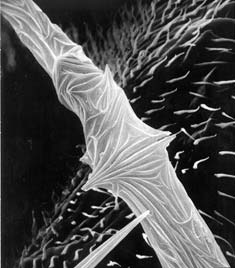To understand the roles of actin cytoskeletal structures in specialized cell types, Professor Miller's lab uses genetic and molecular genetic techniques to alter the function of particular proteins of the actin cytoskeleton.
Multicellular organisms have many different cell types that are specialized to perform processes important to the normal functioning of the organism. Generating the specialized morphologies and functional properties of these cells usually depends on actin cytoskeletal organization. To understand the roles of actin cytoskeletal structures in some of these specialized cell types, the Miller lab uses genetic and molecular genetic techniques to alter the function of particular proteins of the actin cytoskeleton. These studies use the model system, Drosophila, because this type of functional manipulation is relatively straightforward.
Examination of resulting disruptions of cell morphology and function using cell biological, biochemical, and imaging methods both in vitro and in vivo (using GFP and other probes), permit understanding of contributions and regulation of activity of these specific proteins. In addition, these studies illustrate the general functions of actin structures present in cells. Because actin and its associated proteins are highly conserved across all eukaryotic species, the information obtained about the mechanism of actin cytoskeletal organization and function is widely applicable.




